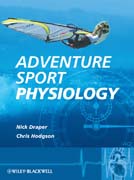
This unique textbook provides a thematic approach to adventure sports physiology based upon applications to specific adventure sports. It covers basic aspects of physiology related to the demands of the activity, training for improving performance, and safety factors. After a brief historical introduction, subsequent chapters cover basic physiology and nutrition and then apply these principles to a variety of land and water based sports including kayaking, canoeing, sailing, windsurfing, climbing, mountaineering and skiing. The concluding chapters deal with medical factors including risk assessment for individual participants and activities alike. Each chapter includes learning objectives, a good range of tests, problems and information about further reading. INDICE: Acknowledgements. Preface. PART I: THE FOUNDATIONS OF ADVENTURE SPORT PHYSIOLOGY. 1. A Historical Perspective: The Context of Adventure Physiology. 1.1 The earliest physiologists. 1.2 The founders of exercise physiology. 1.3 The development of environmental physiology. 1.4 The origins of adventure physiology. 1.5 The development of adventure sports. 2. Nutrition for Health and Performance. 2.1 Introduction to nutrition. 2.2 Carbohydrates. 2.3 Fats. 2.4Proteins. 2.5 Vitamins. 2.6 Minerals. 2.7 Water. 3. The Structure and Functioning of the Human Body. 3.1 The cellular basis for life. 3.2 Skeletal system. 3.3 Nervous system. 3.4 Endocrine system. 3.5 Summary and study questions. 4. Fundamental Systems for Adventure Sports. 4.1 Muscular system. 4.2 Respiratorysystem. 4.3 Cardiovascular system. 4.4 Energy systems. 4.5 Summary and study questions. 5. Training Fundamentals. 5.1 Introduction to training methodology.5.2 Developing and designing training programmes. 5.3 Summary and study questions. PART II: THE PHYSIOLOGICAL DEMANDS OF ADVENTURE SPORTS. 6. Power and Power Endurance: The Explosive Activities. 6.1 Introduction. 6.2 Muscle fibre types. 6.3 The phosphagen system. 6.4 Physiological response to power and power endurance activities and fatigue. 6.5 Physiological adaptations to power training. 6.6 Nutritional ergogenic aids to power performance. 6.7 Summary and studyquestions. 7. Anaerobic Endurance: The Lactate Tolerance and Management Activities. 7.1 Introduction. 7.2 Glycolysis. 7.3 Physiological response to anaerobic endurance activities and fatigue. 7.4 Physiological adaptations to anaerobic endurance training. 7.5 Nutritional ergogenic aids to anaerobic performance.7.6 Sport-specific physiology. 7.7 Summary and study questions. 8. The Intermittent Adventure Activities. 8.1 Introduction. 8.2 Physiology of intermittent activities. 8.3 Training and recovery in intermittent activity. 8.4 Nutrition and ergogenic aids for intermittent activities. 8.5 Water immersion. 8.6 The physiology of water-based adventure sports. 8.7 Summary and study questions. 9.Aerobic Endurance I: The High-Intensity Activities. 9.1 Introduction. 9.2 Aerobic-anaerobic transition and lactate threshold. 9.3 Physiological response tohigh-intensity endurance activities. 9.4 Physiological adaptations to training. 9.5 Nutritional ergogenic aids to aerobic performance. 9.6 Physiological challenge of thermal stress. 9.7 The physiology of land-based adventure sports. 9.8 The physiology of water-based adventure sports. 9.9 Summary and study questions. 10. Aerobic Activities II: Lower Intensity Endurance Activities. 10.1 Introduction. 10.2 Aerobic system. 10.3 Physiological response to lower intensity endurance activities. 10.4 Physiological adaptations to training. 10.5 Nutritional ergogenic aids to aerobic performance. 10.6 The effects of hyperbaric and hypobaric condition on performance. 10.7 The physiology of mountaineering.10.8 Summary and study questions. References. Index.
- ISBN: 978-0-470-01510-0
- Editorial: John Wiley & Sons
- Encuadernacion: Cartoné
- Páginas: 456
- Fecha Publicación: 10/10/2008
- Nº Volúmenes: 1
- Idioma: Inglés
